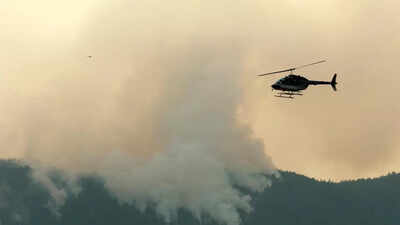Canada wildfire: Thick smoke chokes Midwest, Northeast US; air alerts widen

Thick smoke from hundreds of Canadian wildfires drifted across the border, causing hazy conditions over parts of the Midwest and northeastern United States on Sunday.According to government records, Canada is experiencing its second-worst wildfire season, with nearly 4,000 fires documented this year, NPR reported.The cross-border smoke has impacted air quality across several US states. Wisconsin, Michigan, and Minnesota experienced concerning air quality levels this weekend. Air quality alerts were issued for parts of Illinois and Indiana. Authorities in New York, Vermont, New Hampshire, and Maine advised residents to reduce outdoor activities due to smoke pollution.Bob Oravec, National Weather Service Lead Forecaster, told NPR that current wind patterns are facilitating the movement of polluted air from Canada into the US.“Air is moving at all levels and a lot of times it’ll move in the same direction through the whole depth of the atmosphere, so the smoke is rising into the winds and the winds just transport it downstream, like anything — like a leaf getting blown,” Oravec explained.Minnesota’s Pollution Control Agency extended its statewide air quality alert until noon on Monday, August 4th.According to Minnesota Public Radio, the state is experiencing its longest air quality alert since the agency began issuing alerts in 2008, expected to last seven days.Some areas of Minnesota saw improved conditions on Sunday. Earlier in the weekend, the agency predicted the air quality index (AQI) would reach the severe “red” level statewide, considered unhealthy for all residents.The Pollution Control Agency stated that even healthy individuals might experience symptoms including eye irritation, coughing, or breathing difficulties. They warned of more severe impacts for others.“Sensitive or more exposed individuals may experience more serious health effects, including worsening of existing heart or lung disease and respiratory and cardiovascular conditions, possibly leading to an asthma attack, heart attack, or stroke,” according to the Pollution Control Agency statement.Wisconsin’s Department of Natural Resources extended air quality alerts until noon on Monday, August 4th, primarily in southeastern counties. Michigan officials also extended alerts across all counties through Monday.The Canadian Interagency Forest Fire Centre reported over 700 active fires across Canada on Sunday, predominantly in southern Manitoba, north of Minnesota. Over 500 fires remain uncontrolled, forcing thousands of Canadians to evacuate.Canada has faced wildfires throughout the year. Two individuals perished in a southeastern Manitoba wildfire in May. Similar smoke conditions affected the US in June.Oravec suggests poor air quality could persist in US regions.“It looks like that pattern maintains itself going forward through this week, so it doesn’t really appear to be any big break. There may be a day or so where there’s a temporary break to it, but overall it looks like there is potential for additional smoke to be transported southeastward into the United States,” he said.On Sunday afternoon, IQAir ranked Detroit, Chicago, and Minneapolis among the US cities with the most polluted air.




